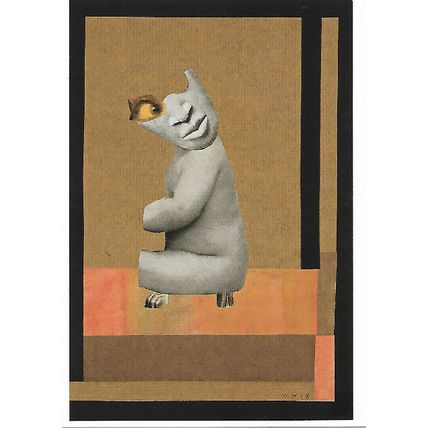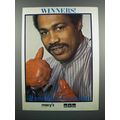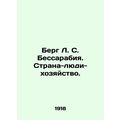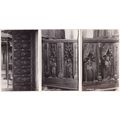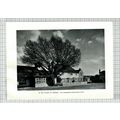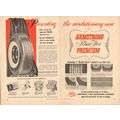Höch, Hannah - Aus der Sammlung - photomontage -Whitechapel Gallery art postcard
- Condition : Unused
- Dispatch : Next Day
- Brand : None
- ID# : 230643809
- Quantity : 1 item
- Views : 7
- Location : United Kingdom

- Seller : justthebook (+1699)
- Barcode : None
- Start : Sun 13 Jul 2025 06:47:32 (EDT)
- Close : Run Until Sold
- Remain : Run Until Sold
Checks/Cheques
 for 1 item(s) edit
for 1 item(s) edit
Shipping Calculator
More Listings from This Seller view all
Seller's Description
- Art Postcard
- Work of art title: Aus der Sammlung: Aus einem ethnographoshcen Museum
- Artist (if known): Hannah Höch
- Media or other details: photomontage
- Publisher / Gallery: Whitechapel Gallery (London) / Scottish National Gallery of Modern Art
- Postally used: no
- Stamp & postmark details (if relevant):
- Size: Modern
- Notes & condition details:
NOTES:
Size: 'Modern' is usually around 6in x 4in or larger / 'Old Standard' is usually around 5½in x 3½in. Larger sizes mentioned, but if you need to know the exact size please ask as this can vary.
All postcards are not totally new and are pre-owned. It's inevitable that older cards may show signs of ageing and use, particularly if sent through the post. Any faults other than normal ageing are noted.
Stock No.: A1352
Please ask if you need any other information and I will do the best I can to answer.
------------------------------------------------
Postage and packing charge should be showing for your location (contact if not sure).
UK - PayPal, Cheque (from UK bank) or postal order
I will give a full refund if you are not fully satisfied with the postcard.
----------------------------------------------
Hannah Höch (German: [hœç]; 1 November 1889 – 31 May 1978) was a German Dada artist. She is best known for her work of the Weimar period, when she was one of the originators of photomontage.[1] Photomontage, or fotomontage, is a type of collage in which the pasted items are actual photographs, or photographic reproductions pulled from the press and other widely produced media.[2]
An important element in Höch's work was the intention to dismantle the fable and dichotomy that existed in the concept of the "New Woman": an energetic, professional, and androgynous woman, who is ready to take her place as man's equal. Her interest in the topic was in how the dichotomy was structured, as well as in who structures social roles.
Other key themes in Höch's works were androgyny, political discourse, and shifting gender roles. These themes all interacted to create a feminist discourse surrounding Höch's works, which encouraged the liberation and agency of women during the Weimar Republic (1919–1933) and continuing through to today.
Biography
Portrait of Hannah Höch (1933), by Chris Lebeau
Hannah Höch was born Anna Therese Johanne Höch[3] in Gotha, Germany.[4] Although she attended school, domesticity took precedence in the Höch household. In 1904, Höch was taken out of the Höhere Töchterschule in Gotha to care for her youngest sibling, Marianne.[5] In 1912 she began classes at the college of Applied Arts in Berlin under the guidance of glass designer Harold Bergen.[6] She chose the curriculum in glass design and graphic arts, rather than fine arts, to please her father.[6]
In 1914, at the start of World War I, she left the school and returned home to Gotha to work with the Red Cross.[7] In 1915 she returned to Berlin, where she entered the graphics class of Emil Orlik at the National Institute of the Museum of Arts and Crafts.[8] Also in 1915, Höch began an intimate relationship with Raoul Hausmann, a later activist of the Berlin Dada movement.[7] Höch's involvement with the Berlin Dadaists began in earnest in 1917. Höch, as the only woman among the Berlin group, was singled out for her self-sufficiency, masculine presentation, and bisexuality, as she consistently addressed themes of the "New Woman" who was free to vote, to begin and enjoy sexual encounters and to seek financial independence.[9]
From 1916 to 1926, she worked in the handicrafts department for the publisher Ullstein Verlag, designing dress, embroidery, lace, and handiwork designs for Die Dame (The Lady) and Die Praktische Berlinerin (The Practical Berlin Woman). The influence of this early work and training can be seen in a number of her collages made in the late 1910s and early- to mid-1920s in which she incorporated sewing patterns and needlework designs. From 1926 to 1929 she lived and worked in the Netherlands. Höch formed many influential friendships and professional relationships over the years with individuals such as Kurt Schwitters, Nelly van Doesburg, Theo van Doesburg, Sonia Delaunay, László Moholy-Nagy, and Piet Mondrian, among others. Höch, along with Hausmann, was one of the first pioneers of the art form that would come to be known as photomontage.
Listing Information
| Listing Type | Gallery Listing |
| Listing ID# | 230643809 |
| Start Time | Sun 13 Jul 2025 06:47:32 (EDT) |
| Close Time | Run Until Sold |
| Starting Bid | Fixed Price (no bidding) |
| Item Condition | Unused |
| Bids | 0 |
| Views | 7 |
| Dispatch Time | Next Day |
| Quantity | 1 |
| Location | United Kingdom |
| Auto Extend | No |

